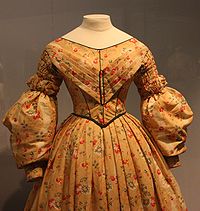Piping (sewing)

In sewing, piping is a type of trim or embellishment consisting of a strip of folded fabric inserted into a seam to define the edges or style lines of a garment or other textile object. Usually the fabric strip is cut on the bias. It may be made from either self-fabric (the same fabric as the object to be ornamented) or contrasting fabric, or of leather.[1]
Today, piping is common on upholstery and decorative pillows, but it is also used on clothing. Piped pocket openings, garment edges, and seams are characteristic of Western wear.[2]
References
- ^ Khalje, Susan (August–September 2005). "Threads". 120. Taunton Press: 40–45.
{{cite journal}}: Cite journal requires|journal=(help) - ^ How the West Was Worn. Harry N. Abrams. 2001. pp. 181, 194, 199. ISBN 0-8109-0615-5.
{{cite book}}: Cite uses deprecated parameter|authors=(help)
